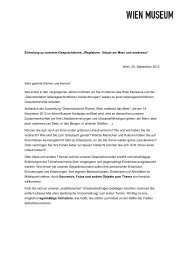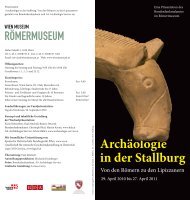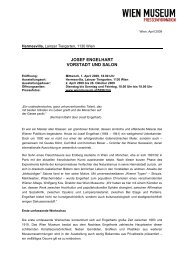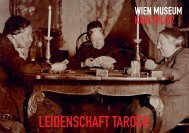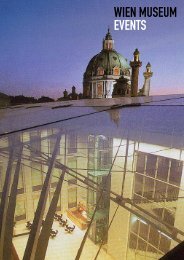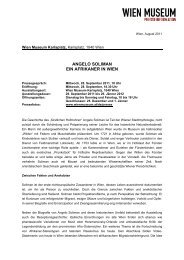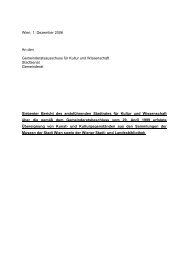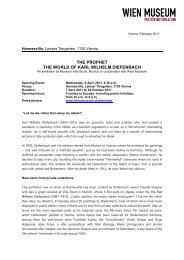Klimt. The Wien Museum Collection
Klimt. The Wien Museum Collection
Klimt. The Wien Museum Collection
Create successful ePaper yourself
Turn your PDF publications into a flip-book with our unique Google optimized e-Paper software.
<strong>Wien</strong> <strong>Museum</strong> Karlsplatz, Karlsplatz, 1040 Vienna<br />
KLIMT<br />
THE WIEN MUSEUM COLLECTION<br />
Vienna, May 2012<br />
Press conference: Tuesday, May 15, 2012, 10 a.m.<br />
Opening: Tuesday, May 15, 2012, 6.30 p.m.<br />
Exhibition venue: <strong>Wien</strong> <strong>Museum</strong> Karlsplatz, 1040 Vienna<br />
Duration: May 16 to September 16, 2012<br />
Opening hours: Tuesday to Sunday and public holidays, 10 a.m. to 6 p.m.<br />
Press photos: www.wienmuseum.at/de/presse<br />
<strong>The</strong> <strong>Klimt</strong> <strong>Collection</strong> of the <strong>Wien</strong> <strong>Museum</strong> impresses not only by its size, but its variety. It<br />
encompasses all his creative periods from his student days, his first major commissions in the 1880s<br />
right through to the year before his death in 1918. <strong>The</strong>re are two absolute masterpieces amongst the<br />
paintings, ‘Pallas Athene’ and the portrait of Emilie Flöge, as well as a fascinating watercolour ‘Interior<br />
view of the old Imperial and Royal Burgtheater’, a commission from 1887/88 that brought the young<br />
aspiring painter public recognition. Most of all the collection comprises around 400 drawings, as well<br />
as rarities such as the scandalous poster, uncensored, of the first exhibition of the Secession, <strong>Klimt</strong>’s<br />
cloak that he wore when painting, precious prints, vintage prints of portrait photographs, the painter’s<br />
death mask as well as Egon Schiele’s drawing of <strong>Klimt</strong> on his death bed.<br />
Kimt’s 150th anniversary offers an opportunity to see the City of Vienna’s collection in its entirety for<br />
the first time, helping us to appreciate the sheer diversity of an artist at the threshold of the 19 th to the<br />
20 th century. Especially the drawings – sketches for his major works as well as independent erotic<br />
sheets – allow a fascinating view from within of <strong>Klimt</strong>’s development and working methods: a close-up<br />
of an artist.<br />
<strong>The</strong> exhibition concept is radical considering the masses of material available: it is deliberately not a<br />
typical presentation of chosen masterpieces, but rather ‘<strong>Klimt</strong> in his entirety’ as owned by the <strong>Wien</strong><br />
<strong>Museum</strong>. <strong>The</strong> design of the exhibition by BWM Architects successfully transforms the rigorous<br />
approach of the curators into an impressive overall picture, by the way pictures are hung in several<br />
rows. At the same time a subtle accentuation on key works creates a guiding thread for the visitor<br />
through <strong>Klimt</strong>’s work.<br />
By means of video interviews the exhibition raises provocative questions concerning today’s approach<br />
to <strong>Klimt</strong>, be it uncritical worship or unrestrained selling-off or sentimentalising. How much ‘<strong>Klimt</strong>isation’<br />
(Ludwig Hevesi) can Vienna bear in the long run? Where is the dividing line between the successful<br />
city branding ‘Vienna around 1900’ and a complete overdose of <strong>Klimt</strong>? Is every little pencil drawing a<br />
masterpiece? Also on view are merchandising products connected with <strong>Klimt</strong> acquired for the
collection in years gone by or posted by users from all over the world as part of the much noticed<br />
Facebook campaign ‘Worst of <strong>Klimt</strong>’. In the Atrium of the <strong>Wien</strong> <strong>Museum</strong> the exhibition is extended by<br />
a show of posters from the <strong>Wien</strong>bibliothek of <strong>Klimt</strong> exhibitions in the 20 th century, and <strong>Klimt</strong> imitations<br />
in advertising graphics in the 1970s and 80s. A collection catalogue is published by Hatje Cantz<br />
Verlag in German and English.<br />
<strong>The</strong> history of the collection<br />
<strong>The</strong> <strong>Klimt</strong> <strong>Collection</strong> of the <strong>Wien</strong> <strong>Museum</strong> developed from various acquisitions and donations from the<br />
past 120 years. As early as 1893 an original drawing was donated to the City <strong>Museum</strong> which was won<br />
as the lady’s prize at a ball of the City of Vienna. <strong>The</strong> first important drawings ‘Junius’, ‘Sculpture’ and<br />
‘Tragedy (created for the model of ‘Allegories. New Series 1895-1900’) were bought in 1901. In 1907<br />
the watercolour ‘Auditorium in the old Burgtheater’ followed.<br />
In 1921 when Vienna became an independent state of Austria, the City <strong>Collection</strong>s were given the<br />
portrait of Emlie Flöge from the collections of the Lower Austria State <strong>Museum</strong>. In 1928 the posters for<br />
the Secession exhibitions were acquired followed by further drawings. Franziska <strong>Klimt</strong>, widow of<br />
Gustav’s brother Georg donated a total of 273 drawings to the <strong>Museum</strong> in 1944, turning the collection<br />
with one fell swoop into the biggest in the world.<br />
Under the directorship of Franz Glück further works were acquired in the 1950s and 60s, for example<br />
33 drawings from a private collection in 1951. <strong>The</strong> famous painting ‘Pallas Athene’ was bought from<br />
an art dealer in 1954. In 1965 the portrait of Marie Moll, a signed chalk drawing, was acquired from a<br />
private Canadian owner – the last new <strong>Klimt</strong> acquisition for a long time. Only in the 1980s did two<br />
further sheets – work studies for the university faculty paintings ‘Jurisprudence’ and ‘Medicine’ –<br />
become part of the <strong>Wien</strong> <strong>Museum</strong> <strong>Collection</strong>. <strong>The</strong> three paintings ‘Portrait of Emilie Flöge’, ‘Pallas<br />
Athene’, and ‘Love’ can be seen all year round in the permanent collection. <strong>The</strong> paper works cannot<br />
be exhibited all the time for reasons of conservation. <strong>The</strong> last <strong>Klimt</strong> exhibition took place in 1984 and<br />
since the 1980s many <strong>Klimt</strong> objects from the <strong>Wien</strong> <strong>Museum</strong> could be seen in various exhibitions all<br />
over the world as part of ‘Vienna around 1900’.<br />
Tour through the exhibition<br />
<strong>The</strong> exhibition starts with nude drawings and studies of children, created by Gustav <strong>Klimt</strong> during his<br />
time at the <strong>Wien</strong>er Kunstgewerbeschule (1876 – 1881) where he studied to become an arts teacher.<br />
During this time he was also commissioned to paint portraits from photographs, by means of which the<br />
young artist contributed to the family income. <strong>The</strong> first larger group of objects was acquired by the<br />
<strong>Wien</strong> <strong>Museum</strong> in 1901 from publishers Gerlach & Schenk. This publishing house had brought out a<br />
model collection for late-historicist arts and crafts, illustration and advertising in which well known<br />
artists presented their idea of modern allegories, including <strong>Klimt</strong>. From 1895 to 1900 followed<br />
‘Allegories. New Series’ which comprise some of <strong>Klimt</strong>’s most famous drawings, ‘Junius’,’Sculpture’,<br />
and ‘Tragedy’.<br />
Section 3 collects works from 1883-1898, when <strong>Klimt</strong> was able to execute some lucrative<br />
commissions with his brother Ernst and fellow-student Franz Matsch under the name of ‘Künstler-<br />
Compagnie’, like for example the painting of the staircase in the Kunsthistorisches <strong>Museum</strong> and in
the Burgtheater – a number of study sheets of this are contained in the <strong>Wien</strong> <strong>Museum</strong> <strong>Collection</strong>. <strong>The</strong><br />
section gathers the works around the large-format watercolour ‘Interior view of the old Imperial and<br />
Royal Burgtheater’. In 1887 <strong>Klimt</strong> and Franz Matsch were commissioned by the City of Vienna to<br />
capture the auditorium of the old Court Burgtheater on Michaelerplatz before its demolition. <strong>Klimt</strong>’s<br />
work shows the view of the auditorium from the stage, with over 100 celebrities from art, politics and<br />
science, as well as the nobility and bourgeoisie. Along with the official ‘picture puzzle’ of Viennese<br />
society, the <strong>Wien</strong> <strong>Museum</strong> <strong>Collection</strong> contains 25 drawings as well as a sketch book.<br />
Chapter 5 is devoted to <strong>Klimt</strong>’s Works for the Secession, whether designs for the Secession building,<br />
the scandalous poster for the first exhibition, the oil painting ‘Pallas Athene’ (the programmatic image<br />
of the Secession par excellence) as well as sketches for the Beethoven Frieze. A central role in <strong>Klimt</strong>’s<br />
career is occupied by his allegorical depictions of the faculties of Philosophy, Medicine and<br />
Jurisprudence, which he completed from 1894/95 to 1903 as commissioned works for the Ceremonial<br />
Hall of the new University, and which was ultimately turned down by this institution. <strong>Klimt</strong>’s<br />
interpretation caused a storm of controversy: the heavily symbolist picture for Philosophy gathers a<br />
stream of humans hovering in space, a sphinx and a woman’s head. Medicine showed not only the<br />
goddess of health, Hygeia, but also naked women, men, children and old people as a personification<br />
of pain, death and transience. <strong>The</strong> central motif of Jurisprudence was an old man in the clutches of a<br />
polyp-like monster. <strong>The</strong> <strong>Wien</strong> <strong>Museum</strong> owns 57 studies of these uncompromising pictures.<br />
Chapter 7 brings together figure studies, which reflect <strong>Klimt</strong>’s steady search for the perfect form, but<br />
also his continuous treatment of certain sets of themes. Section 8 concentrates on portraits. <strong>Klimt</strong>’s<br />
early work is epitomised, for example, by the naturalistic ‘Portrait of an Unknown Lady’; in the<br />
groundbreaking portrait of Emilie Flöge (1902), Gustav <strong>Klimt</strong> wraps a woman’s body in an ornamental<br />
surface for the first time, rather than in a real item of clothing. Furthermore, diverse sketches for other<br />
famous portraits of women are on display (Sonja Knips, Paula and Amalie Zuckerkandl, Adele Bloch-<br />
Bauer, Mäda and Eugenia Primavesi among others), as well as serial sketches for anonymous<br />
portraits which can be categorised as finger exercises or snapshots.<br />
Around a quarter of Gustav <strong>Klimt</strong>’s drawings from the <strong>Museum</strong> <strong>Collection</strong> are nude studies or erotic<br />
depictions from all periods of creation, which are largely identifiable as studies for the well-known<br />
paintings (Death and Life, Water Snakes I & II, Leda etc.). <strong>The</strong>mes here include growth and decay, as<br />
well as same-sex love between women. Bodies embracing, and lovers are motifs which Gustav<br />
<strong>Klimt</strong> varied in his painting over many years. <strong>The</strong> most well-known interpretation is depicted by his<br />
most famous painting <strong>The</strong> Kiss (1907/08), for which design sketches are to be found in the <strong>Wien</strong><br />
<strong>Museum</strong> <strong>Collection</strong>, as for the Stoclet Frieze, which varied the theme.<br />
For the <strong>Wien</strong> <strong>Museum</strong>, it is not only <strong>Klimt</strong>’s importance for art history that matters, also his significance<br />
for the city’s cultural history: as a central figure of ‘Vienna around 1900’, he has long since mutated<br />
into a ‘city saint’. To document this aspect, <strong>Klimt</strong> memorabilia and souvenirs have been acquired for<br />
the <strong>Museum</strong> <strong>Collection</strong>, which are shown in a separate small area. Moreover, screens show over 100<br />
suggestions for the ‘Worst of <strong>Klimt</strong>’ examples that have been tracked down by Facebook users since<br />
February 2012. A <strong>Wien</strong> <strong>Museum</strong> jury has selected a ‘Worst of the Worst’: a decorative egg with ‘Kiss’<br />
figures, which rotate to the melody of ‘Can’t Help Falling in Love’ – purchased in a shop on<br />
Kärntnerstraße.
<strong>The</strong> catalogue to the exhibition, edited by curator Ursula Storch, gathers contributions from Marian<br />
Bisanz-Prakken, Brigitte Borchhardt-Birbaumer, Georg Gaugusch, William M. Johnston, Sophie Lillie,<br />
Ursula Storch and Kerstin Krenn. <strong>The</strong> accompanying programme offers, among other things, two<br />
controversial <strong>Klimt</strong> topics (<strong>Klimt</strong> overkill and <strong>Klimt</strong>’s image of women), talks, and a city tour in the<br />
footsteps of the artist.<br />
Exhibition sponsors<br />
Sponsors of the exhibition ‘<strong>Klimt</strong>. <strong>The</strong> <strong>Wien</strong> <strong>Museum</strong> <strong>Collection</strong>’ are <strong>Wien</strong>er Städtische Versicherung<br />
AG Vienna Insurance Group as well as Münze Österreich, which has issued a special coin series to<br />
mark the 150th birthday of Gustav <strong>Klimt</strong>, available in the <strong>Wien</strong> <strong>Museum</strong> Shop.
<strong>Wien</strong> <strong>Museum</strong> Karlsplatz, Karlsplatz, 1040 Vienna<br />
KLIMT<br />
THE WIEN MUSEUM COLLECTION<br />
Vienna, May 2012<br />
Press conference: Tuesday, May 15, 2012, 10 a.m.<br />
Opening: Tuesday, May 15, 2012, 6.30 p.m.<br />
Exhibition Venue: <strong>Wien</strong> <strong>Museum</strong> Karlsplatz, 1040 Vienna<br />
Duration: May 16 to September 16, 2012<br />
Opening hours: Tuesday to Sunday and public holidays, 10 a.m. to 6 p.m.<br />
Press photos: www.wienmuseum.at/de/presse<br />
Admission: Adults: 8 €. Reduced Rates 6 € (pensioners, <strong>Wien</strong>-Card holders, Ö1-<br />
Club members, the disabled, students up to 27, apprentices, military<br />
and civilian service conscripts, groups of more than 10 people)<br />
School children and young adults under 19 - admission free!<br />
Every first Sunday of the month - admission free!<br />
General guided tours: Sundays and public holidays, 11 a.m. and 4 p.m.<br />
Prior booking for groups: Tel.: (+43 1) 505 87 47- 85180;<br />
Email: service@wienmuseum.at<br />
Visitor information: Tel (+43 1) 505 87 47-0, www.wienmuseum.at;<br />
e-mail: service@wienmuseum.at<br />
Curatorial team: Ursula Storch with Kerstin Krenn<br />
Exhibition production: Isabelle Exinger<br />
Exhibition architecture: BWM Architekten<br />
Graphics: Perndl+Co<br />
Catalogue: <strong>Klimt</strong>. Die Sammlung des <strong>Wien</strong> <strong>Museum</strong>s. Verlag Hatje Cantz, 2012;<br />
c. 300 pages.<br />
Main sponsor <strong>Wien</strong> <strong>Museum</strong>: <strong>Wien</strong>er Stadtwerke<br />
Exhibition sponsors: <strong>Wien</strong>er Städtische Versicherung AG Vienna Insurance Group;<br />
Münze Österreich<br />
Press: Peter Stuiber, <strong>Wien</strong> <strong>Museum</strong><br />
Tel (+43 1) 505 87 47 - 84019, Fax (+43 1) 505 87 47 - 7201<br />
e-mail: peter.stuiber@wienmuseum.at<br />
Barbara Wieser, <strong>Wien</strong> <strong>Museum</strong><br />
Tel (+43 1) 505 87 47 - 84068, Fax (+43 1) 505 87 47 - 7201<br />
e-mail: barbara.wieser@wienmuseum.at<br />
www.wienmuseum.at



